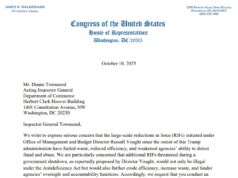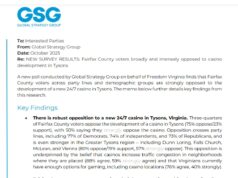In 1965, Virginia’s Democratic Party published a progressive platform.
“We believe that government exists to serve the people, that public office is a public trust, and that the policies of government must adapted to changing times. We are for:
• “Stronger conflict of interest laws.”
• “Improvement of consumer protections laws.”
EDUCATION
• “Expand resources and facilities for state institutions of higher learning.”
• “Higher teacher salary scales, and retirement and sick leave benefits above, not below, the American average.”
TRANSPORTATION
• “Provide more funds for improved commuter roads and highway maintenance.”
• “Create a rapid transit system for Northern Virginia.”
MENTAL HEALTH
• “Alleviate shortages in mental health facilities.”
ECONOMIC DEVELOPMENT
• “Improve workmen’s compensation laws.”
Half a century ago, these progressive values were controversial, aggressive — and winning. 1965 was a Democratic sweep. It was the last time, prior to 2014, that Democrats won all of Virginia’s state-wide offices (Governor, Lt. Governor, Attorney General) while holding both US Senate seats. In 1965, Democrats also held the Presidency and majorities in both houses of Congress.
These bullets still speak to voters in 2014. They share an overarching message that binds them into a Democratic Party “brand” that endures over time, regardless of candidate or crisis.
Democrats are the party of everyday working people. A level playing field, where every American has opportunities for success, is the Democratic goal. Democrats have the backs of the Middle Class.
Just as each bullet point from 1965 fits under this brand, so do 2014’s big issues that separate progressive Democrats from right-wing Republicans. Medical care, income inequality, Social Security, consumer protection, tax fairness, mass transit, public education, workers rights, pensions, campaign finance – all are schisms between progressive Democrats and right-wing Republicans. All are subsets of the larger and unending struggle between working Americans and corporate wealth.
Under the American political system, working people and corporate wealth have separate political parties. This divide is the battlespace of politics, setting the starting conditions for every campaign. While individual candidates must define themselves, energize their supporters and get out the vote, national parties convey the overall brand that grounds every contest.
The corporate Republican brand is “less government, lower taxes.” This brand benefits management, shareholders and the wealthy. The Democratic brand is “a level playing field, where every American has opportunities for success.” This brand grows the Middle Class.
Each party can, and should, articulate why its brand is best for America as a whole. Republicans do this; their message is clear, concise and unified. Pull the string on any Republican and you will hear, “less government, lower taxes.”
Democrats, wanting to be all things to all people, shy from uniformity. Pull the string on any Democrat and you will hear a string of unrelated talking points ranging from abortion to gun safety and the minimum wage. Unlike FDR with the New Deal and LBJ with the Great Society, today’s Democrats refuse to define themselves.
Perversely, when today’s Democrats refuse to define themselves, Republican do it for them. Republicans define Democrats as the party of “bigger government and higher taxes.” This damning characterization handicaps every Democratic candidate from the starting whistle.
The Democratic brand of “a level playing field, where every American has opportunities for success,” is both good politics and good policy. Democrats have always been the builders of the Middle Class, whose defenses are even more valuable to voters today due the harms levied by corporate wealth over the last two decades. With information age technologies concentrating more and more power and influence in fewer and fewer people, armies of lawyers, lobbyists and PR pros have skewed wealth in America to unbalanced levels unseen in a century.
Highly concentrated wealth is simultaneously a threat to liberty and to economy. As Justice Brandeis said in 1941, “We may have democracy, or we may have wealth concentrated in the hands of a few, but we can’t have both.” Historically, aristocracy is incompatible with democracy. With the 400 richest Americans controlling wealth equal to the GDP of Russia, we have already reached Czarist levels of concentrated wealth. Unless the Middle Class regains control of government, we risk even higher concentrations which will inevitably lead to Czarist consequences.
American growth and stability go hand in hand with Middle Class growth. America was strongest when average working Americans were the direct focus of government investment. Indirect, trickle-down benefits channeled through corporate sieves have proven to only produce arid and isolated crops of stunted economic growth.
The Democratic Party should trumpet its traditional roots with a full-throated, unified and singular focus on — Middle Class growth and opportunity. The Democratic brand is “a level playing field, where every American has opportunities for success.”













